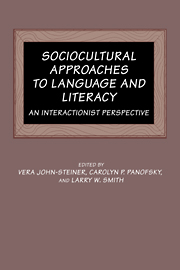1 - Introduction
Published online by Cambridge University Press: 05 November 2011
Summary
In the past two decades, a shift in research perspectives has led to a transformation in how educational theorists think about language and literacy. Converging research from anthropology, linguistics, psychology, and education has given rise to new models of language and literacy development. The common element is a social and functional approach, largely replacing earlier behaviorist and nativist models.
L. S. Vygotsky's Thought and Language (1962) and Mind in Society (1978) are foundations for a new model of language and development, along with several other changes in the human sciences. We sketch some of these changes to clarify our own interactionist framework.
TENETS OF THE THEORETICAL FRAMEWORK
1. Recent studies of language and literacy use functional rather than structural models. Rather than regarding grammatical structure as autonomous, Fillmore (1968), Chafe (1970, 1982), Halliday (1975, 1978), and Silverstein (1976, 1985) analyze grammatical features of language in terms of their use. Particularly significant to us is the focus these scholars, and some philosophers of language (Austin, 1962; Grice, 1975; Searle, 1969), put on communicative intent and on the representational functions of language.
2. There has been increased emphasis on social interaction as the generative context for language mastery. Gordon Wells (1981) describes language as interaction of “people collaborating in the negotiation of meaning; talk as a form of social action; the reciprocal influence of language and context” (p. 15). Jerome Bruner (1983) refers to this interaction as “Language Acquisition Support System” (LASS).
- Type
- Chapter
- Information
- Sociocultural Approaches to Language and LiteracyAn Interactionist Perspective, pp. 1 - 34Publisher: Cambridge University PressPrint publication year: 1994

